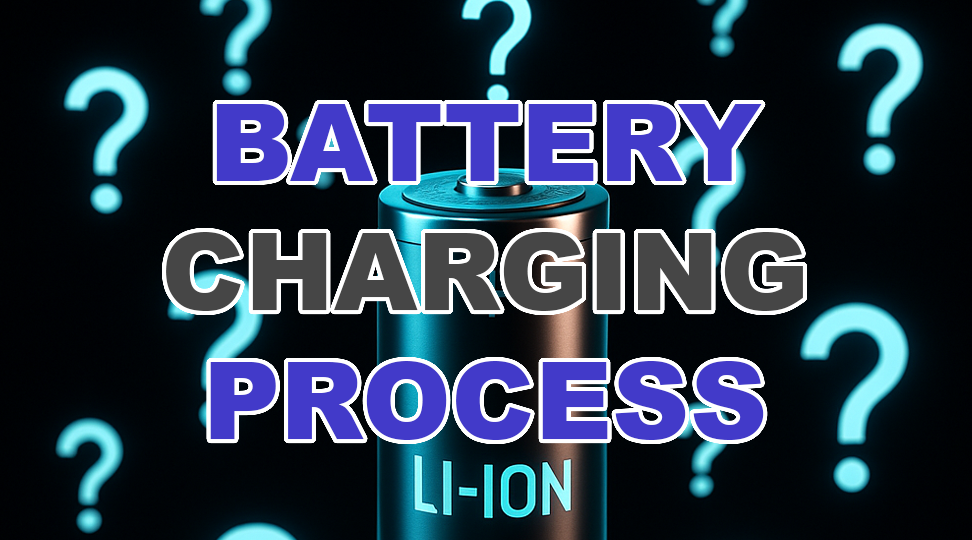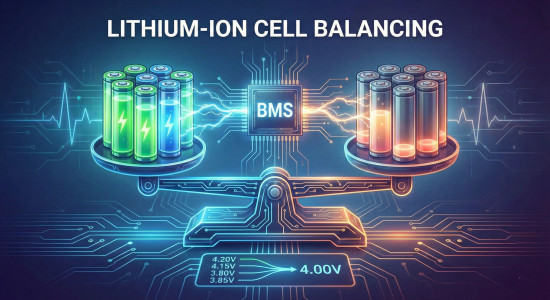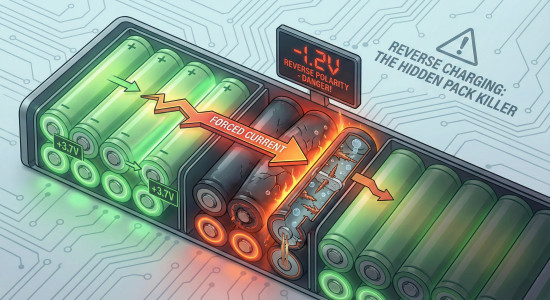
How Lithium-Ion Battery Charging Really Works: Inside the Cell, Charging Phases, and SEI Formation
Table of Contents
This article explains how the lithium-ion battery charging process actually works. We’ll start with the internal structure of a lithium-ion cell, then cover the charging phases, the electrochemical reactions, formation of the SEI layer, how energy is transferred from the charger to the cell, and proper charging practices.
Internal Structure of a Lithium-Ion Cell
Inside a lithium-ion cell you have a cathode, which contains a lithium metal oxide, and during charge lithium is extracted from here. You also have an anode; it's usually made of graphite, and during charge lithium is inserted here, which is also called intercalated. There's an electrolyte between the cathode and the anode. It's an ionic conductor between both of these electrodes and it allows lithium ions to move, but electrons cannot pass through it. There's also a separator that physically separates the cathode and anode while permitting ion flow. Electrons flow through the external circuit from the charger into the anode. Lithium ions then move internally through the electrolyte from the cathode to the anode to maintain the charge balance.
Charging Phases
Charging is typically done in two stages: constant current and constant voltage. (I say typically because you don't always have to do the constant voltage stage. In fact, many devices completely skip that stage.)
Constant Current Stage
The first constant current stage is a fixed current—so whatever you set, say 3 amps or 5 amps, it will maintain that current during this phase, and it will allow the cell voltage to rise. It does this by automatically changing the voltage to whatever it needs to be above the cell voltage to maintain the amount of current that you set. The cell voltage rises as lithium accumulates in the anode. This is the charging stage that delivers the most capacity the fastest.
Constant Voltage Stage
After that is the constant voltage stage. Once the cell reaches its upper limit—for lithium-ion NMC chemistry that would be 4.2 per cell—the charger switches to constant voltage mode, where it holds the voltage solid but lets the current slowly fall. The current will decrease or taper down as the battery approaches its full charge voltage.
Charge Termination
Charging is generally terminated when the current falls below a set cutoff value, say 10 milliamps for some chargers or 100 milliamps for others. If you're charging with a bench power supply or something like that, it will never cut off charging. It will just equalize and stabilize, and as long as you don't have any self-discharge or a BMS that draws a lot of current, no current will appear to be flowing on the meter. But some tiny, tiny bit will still flow because all cells have some amount of internal self-discharge, and the BMS—even simple ones—have components that have to be powered. The current will fall so low that on just about any power supply or meter it will say zero.
Electrochemical Reactions During Charge
The cathode undergoes deintercalation and the anode goes under intercalation. The electrons are supplied externally—that’s from the wire, connector, power supply, etc. The stuff outside that you're using to charge the battery is pumping electrons through a system. That's where they stop there at the lithium-ion battery, because, as you know, electrons are negatively charged; lithium ions are made of ions which are positively charged because ions are atoms without their electrons, right? Everybody understands that the flow of electrons is primarily responsible for electricity. When you store energy inside of a battery, you're definitely not using electrons; you're using ions. These externally supplied electrons cause lithium ions to migrate through the electrolyte to the anode.
Solid Electrolyte Interface (SEI) Formation and Abuse
On the first few charge cycles—especially on the first charge cycle—there is an SEI, or solid electrolyte interface, layer that forms on the graphite anode. That SEI formation consumes a small amount of lithium, which is irreversible, but it stabilizes and forms a skin and prevents further parasitic reactions. If you abuse a cell—like overcurrent it, run it too low, or expose it to high temperatures—you'll cause that SEI layer to grow much more than it normally would and make it much less stable.
Energy Transfer from Charger to Cell
How exactly does the charging process work? How is energy transferred from the charger to the cell? Yes, we understand the different charging phases—the constant current, the constant voltage, etc.—but how exactly is the energy transferred?
Well, that all comes down to a voltage difference. If you connect two things together, energy is going to flow from the high voltage to the low voltage as things try to stabilize. If I hook a 12-volt battery up to a 0-volt light—because the light has no power of its own—then the amount of current that flows is a function of the difference in the voltage (so that would just be the voltage itself, right? Because the destination, the load, has zero volts). So the volts of the power supply and the resistance of not only the power supply but also the load and the connection between them—the entire series circuit resistance—along with the voltage difference is what determines how much current flows.
This goes in both directions: if the load has a higher voltage than the power supply, then power will flow from the load to the power supply. Now obviously, in normal circumstances that's not going to happen because a light, a speaker, a fan—they have no voltage; you have to give them voltage. They're already at zero volts. But if you hook a 24-volt battery up to a 20-volt power supply, there's a 4-volt difference in that direction, and lithium-ion batteries and power supplies generally have very, very low resistances, so a lot of current is going to flow from the battery to the power supply unless there is a diode on the output of the power supply that prevents reverse current flow.
So the same phenomenon is taking place when you charge a battery, whether you're properly charging it or improperly charging it, whether you're overcharging it or using too much current. One way or the other, you're connecting that battery to something that has a higher voltage than that battery. The only way to properly charge a lithium-ion battery is to set the voltage to whatever voltage it needs to be to produce the current you want to flow and then slowly increase the voltage over time to maintain that amount of current flow. A constant current power supply or official lithium-ion battery charger does that automatically.
Proper Charging Practices
Proper charging involves controlling both the current and the voltage so that the battery is driven toward full charge without undue stress. Skipping stages, using excessive current, or exposing the cell to abusive conditions can degrade the SEI, cause irreversible capacity loss, or introduce safety risks. Monitoring the tapering current during the constant voltage stage and terminating charge at an appropriate cutoff helps ensure longevity and stability.
Conclusion
That pretty much covers how the lithium-ion battery charging process works. Energy is transferred via voltage difference, lithium ions shuttle between electrodes while electrons flow externally, and careful control of current and voltage—along with respect for the SEI and operating limits—keeps the system stable and effective. We hope this article helped you gain insight on these things. Thank you for reading.


